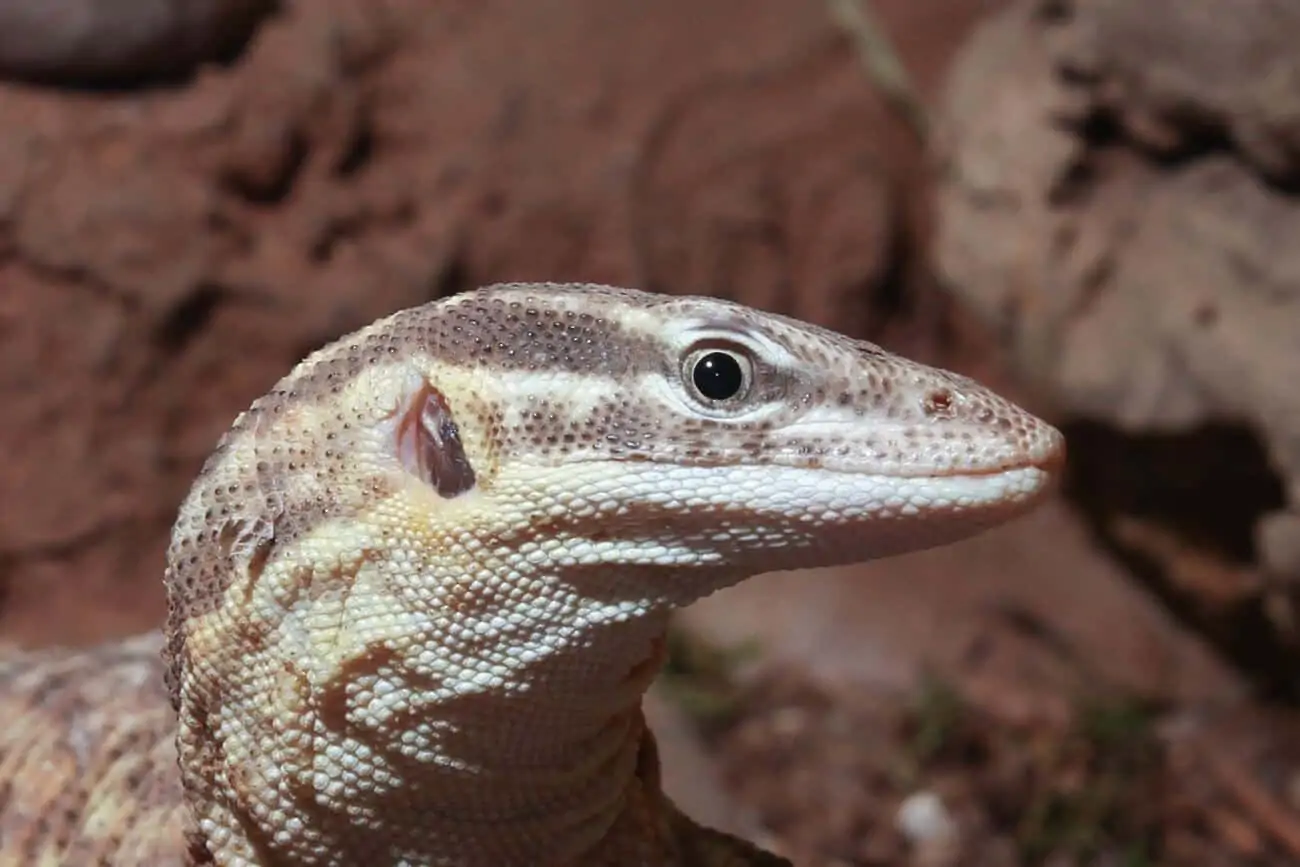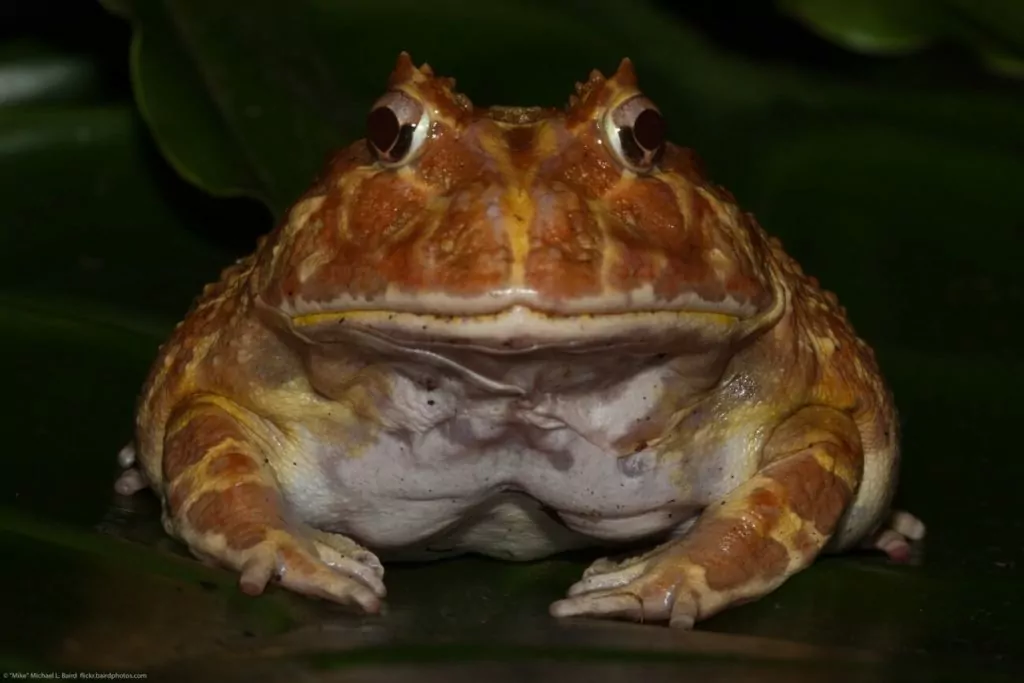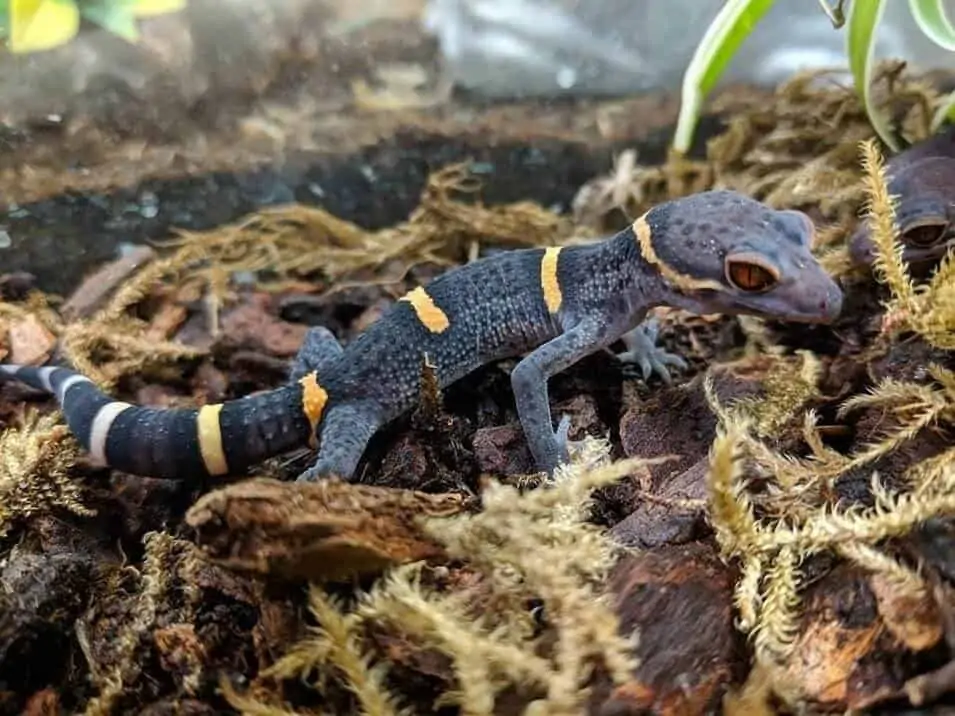Ackies monitors are definitely one of our favorite lizards, and many other owners agree. They have a unique look and mellow temperament which makes them a great pet for just about anyone.
Due to their interesting look and resemblance to the Komodo dragon, there’s a lot of inaccurate information being passed around about this species. You wouldn’t believe some of the things we’ve heard!
But this guide about Ackie monitor care will clear everything up. You’ll learn how to set up their enclosure, what their size is when fully grown, what diet is best, and much more!
Table of Contents
Species Summary
The Ackie monitor (Varanus acanthurus) is an eye-catching reptile with a rather intimidating look!
Often referred to as the Spiny-tailed Monitor or Ackies dwarf monitor, these lizards are part of the same genus as the Komodo Dragon. Take one look at the Ackie monitor and you can definitely see the relationship!
Of course, the Ackie monitor is far gentler than their appearance would lead you to believe. Found throughout arid regions in Australia, these lizards are a very big part of the reptile trade. They’re enjoyed the world over by reptile enthusiasts.
If you want a unique reptile with some quirky behaviors, the Ackie monitor may be for you.
Average Ackie Monitor Size
The average Ackie monitor size is about 24 to 28 inches long when fully grown. This makes them a medium-sized lizard, and is a far cry from the massive size of the Komodo!
Expert Tip: If you want to maximize their size it’s important to provide them with great care while they’re still growing. There are obviously genetic factors that can influence this as well, but that’s outside of your control.
Lifespan
If you’re thinking about getting one of these cool pet lizards, be prepared for a long commitment. Ackie monitors have an average lifespan of 15 to 20 years.
Of course, there are no guarantees with life expectancy. Like any other reptile, Ackies monitors are directly affected by their environments, diets, and overall level of care.
If you don’t put the work into providing your lizard with the best life possible, there’s an increased chance of disease and a shorter lifespan.
Appearance & Colors
There’s no denying that the Ackie monitor is a beautiful reptile. It has a noticeably prehistoric look that reptile enthusiasts love!
While there are a few different color morphs available, the most common you’re going to see is brown. The back of Ackies is dark brown. Accompanying that rich color are contrasting spots and stripes. The spots can vary from bright yellow to a more subdued cream.
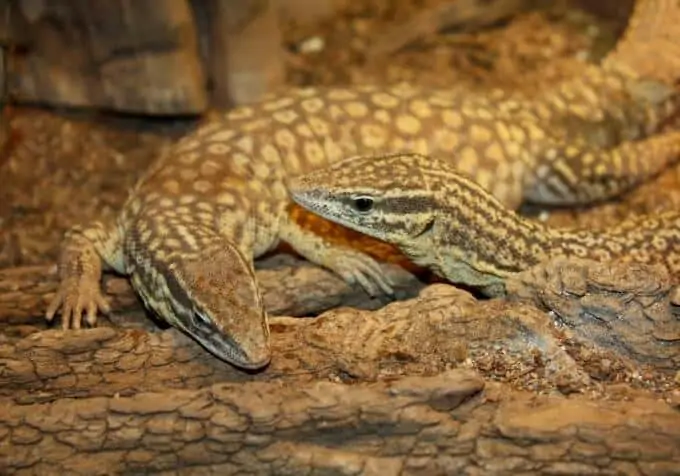
The tail of the Ackie monitor has some cool features, too. First off, it’s very long. In most cases, the tail is about 1.2 to 2.3 times as long as the head and body combined. It makes up most of the length measurement.
And that’s not all.
The rounded tail has spinose scales. The scales create the lizard’s signature spiky look.
Some of those spinose scales extend up the body. They adorn the back of the lizard. However, they tend to be a bit more subtle.
Expert Tip: The differences between males and females are subtle. Generally, the only way to tell the difference is to analyze their length. Males reach slightly longer lengths and have a bigger overall appearance.
Ackie Monitor Care
Ackie monitor care is not nearly as difficult as it seems. These cold-blooded creatures are quite hardy that can adapt well to life in captivity.
However, that doesn’t mean that caring for this reptile will be a walk in the park! Ackie monitors come from tough environments in the wild that take some initial work to replicate.
Because of this, they have some unique care requirements that you can’t ignore. Stick to the following recommendations to ensure that your Ackie thrives.
Enclosure Size
First things first, you’re going to need a sizable enclosure.
Unlike many other lizard species in the pet trade, Ackie monitors aren’t big climbers. In fact, they’re quite the opposite.
These lizards spend a lot of their time burrowing. So, you’re going to need to provide a thick substrate layer to accommodate this. This means you’ll need to have a durable enclosure with some considerable height.
At the very least, we recommend going with an enclosure that measures 48 inches long, 24 inches deep, and 24 inches tall.
Expert Tip: The height measurement is the one you have to pay attention to here. While 24 inches of height is suitable, it’s always better to go with something a bit taller if possible.
Go for a solid tank with thick glass. One of the sides should be screened. Most owners will use a screened lid rather than sliding or swinging side doors to reserve that space for burrowing.
Ideal Habitat Setup
To accommodate their burrowing behavior, you’ll need at least 6 inches of substrate! Some owners will even go as deep as 12 inches!
The best materials are going to be ones that hold onto moisture. Ackies monitors use burrowing to get away from the Australian heat.
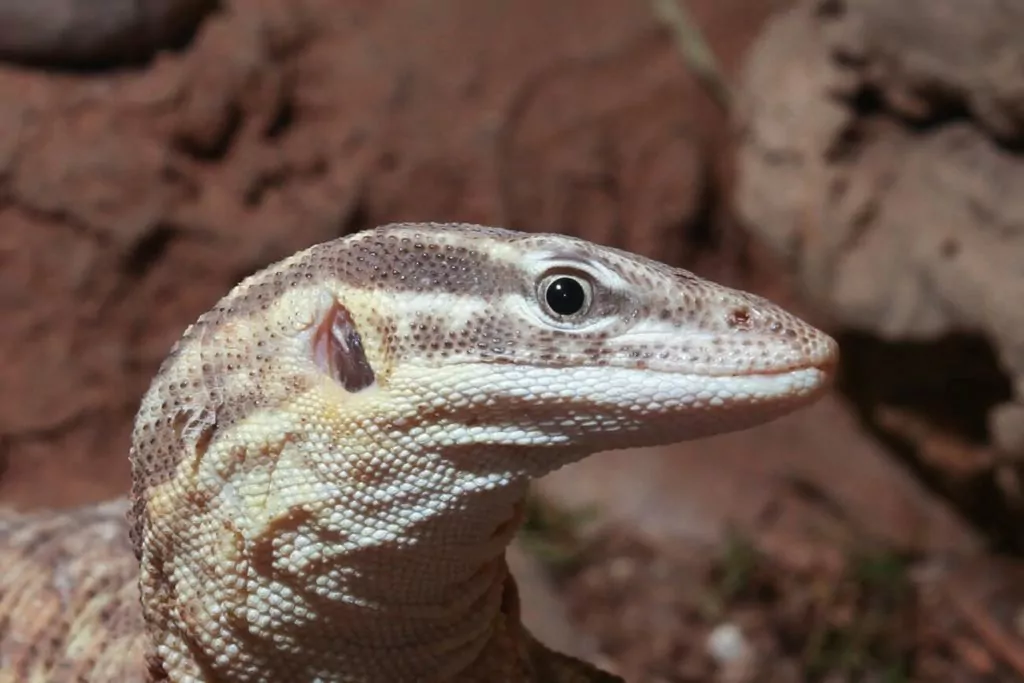
Having a bit of moisture in the substrate will help these lizards cool down and stay hydrated. Cypress chip, coconut fiber, and sand-based reptile substrates work well.
On top of the substrate, you’ll need to implement plenty of natural decorations. In the wild, Ackie monitors usually live by rock outcroppings and will retreat to those rocks whenever they feel scared.
Use natural rocks to recreate their natural environment. You can also use pieces of wood, cork bark stacks, and even faux caves. If you want, artificial plants are good, too.
Taking the extra time to set up a well-planned environment that mimics their natural habitat will go a long way. Not only will your Ackie monitor get more enrichment, they’ll also be much more comfortable and less stressed (which is good for their lifespan).
Temperature & Lighting
Ackie monitors are cold-blooded lizards that come from very hot climates. To keep your lizard healthy, you’ll need to recreate that intense heat.
However, this doesn’t mean blasting the enclosure with light. Instead, it’s best to create a temperature gradient.
The gradient allows the lizard to regulate their body temperature as they see fit. One side of the tank should be hot (this is where the lizard will bask). The opposite side should be significantly cooler.
Here are the temperatures to aim for:
- On the basking side, temperatures should reach a staggering 120°F! Use a basking lamp to achieve this.
- As for the cool side, temperatures should be around 80°F.
If your home gets cooler than 65 degrees at night, you will need to invest in a high-quality heat emitter. Ackies cannot tolerate anything below 65 degrees.
Lights should be kept on for no more than 12 hours a day. These lizards require a normal day/night cycle.
Your Ackie monitor’s enclosure will also need a UVB lamp. The UVB lamp will produce those all-important UVB rays that the lizard needs to stay healthy. UVB rays provide Vitamin D, which is essential for metabolizing calcium.
Like the standard lights, leave the UVB lamp on for about 12 hours a day. Make sure to replace the bulb every six months so that your lizard can continue getting those UVB rays.
Humidity
Ackie monitors need a good amount of humidity to stay healthy. Ideally, the humidity level should be between 65 and 85 percent. Use a hygrometer to check those levels regularly.
Expert Tip: We suggest investing in a high-quality and accurate hygrometer to monitor the humidity effectively. Cheap ones can be inaccurate and cause you to make poorly-informed adjustments to the humidity in their enclosure.
If you chose the right substrate, you shouldn’t have issues maintaining high humidity levels. When levels start to dip, simply mist the enclosure.
Water
Ackie monitors stay hydrated in a couple of different ways. First, they pull moisture from the air ( which is why humidity is so important). They can also pull moisture from the ground when they burrow.
That said, the best way to keep these lizards hydrated is with a water dish! Ackie monitors will use the dish to soak. Make sure that the dish is large enough for the lizard to get in.
Then fill it with filtered and conditioned water. Keep an eye on the dish since it can get filthy very fast. Replace dirty water as soon as you can in order to avoid bacterial issues.
Food & Diet
In the wild, Ackie monitors are known to eat a wide range of foods. They seek out prey and will consume pretty much anything that they can overpower!
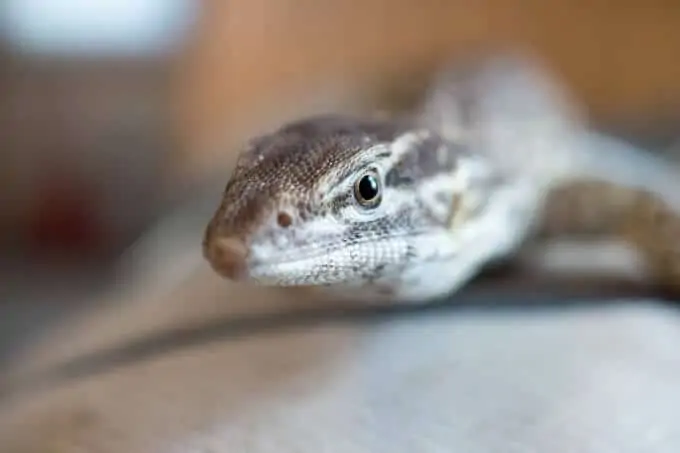
In captivity, you have a lot of options when it comes to their diet. Most owners will stick to prey foods that are easy to obtain.
This includes:
- Rodents
- Dubia roaches
- Crickets
- Mealworms
- Eggs
- Shrimp
You can feed small meals every day. However, always make sure that you’re monitoring your lizard’s body condition.
Ackie monitors are known for having healthy appetites. Since they move less in captivity than they do in the wild, this can cause them to become obese pretty quickly.
The main diet of your lizard should be roaches, crickets, and mealworms. Dust those treats with a powdered calcium supplement a couple of times a week. You can also provide multivitamin supplements weekly.
Expert Tip: Rodent-based meals should be kept to a minimum. One rodent every month or two is fine. However, regular feedings could lead to some health issues.
Potential Health Issues
The biggest health threat to Ackies monitors is metabolic bone disease. Remember how we said that these lizards need UVB lamps to metabolize calcium? If they don’t have that crucial UVB exposure, their bodies cannot use calcium efficiently.
This results in brittle bones, deformities, and a range of other problems. Unfortunately, metabolic bone disease is far too common.
UVB lamps go out after about six months of use, but many owners don’t realize it! There’s no visible light on UVB lamps, meaning there’s not an obvious sign that it needs to be replaced.
To avoid this, make sure that you’re sticking to a replacement schedule. Also, take advantage of calcium supplements to prevent this disease as much as possible.
Behavior & Temperament
Ackie monitors have a temperament that’s pretty well suited for captivity. Once they get comfortable with you, they shouldn’t display any signs of aggression at all!
However, they can get scared if you surprise them.
They are also known to get a bit more volatile in times of stress, such as when their environment is dirty. When this happens, the lizard may whip its tail or snap at you.
As long as you keep their enclosure in good shape, you can easily avoid any nasty behavior.
Throughout the day, Ackie monitors will bask in the light and explore the habitat. They’re naturally inquisitive creatures, so don’t be surprised if you see the lizard eying the room through the glass!
They may also use the environment to get comfortable. For example, you might see them burrowing in the substrate, hiding under plants, or even wedging themselves between some rocks.
Handling Them
For the most part, Ackie monitors don’t have a problem with being handled. However, like any other reptile, you have to build up that trust first.
Give your monitor some time to acclimate to their new home. Once they have started eating regularly, you can try handling them. Approach them slowly and support the body with your hand.
If your lizard instantly retreats or tries to burrow, give them some space. The trick is to let the lizard get comfortable with you rather than forcing anything.
Generally, regular handling will make the Ackies monitor more comfortable with the process. Just take things slow. You’ll get there eventually!
Give Them A Shot!
Now that you know that Ackie monitor care is nothing to be intimidated by, it’s time for you to get one of these lizards for yourself!
With their high intelligence and fun personality, owning one can be very rewarding. The bond you’ll build over time is really something special!
Plus they look pretty darn cool as well.
If you have any neat stories about your Ackies monitor that you’d like to share (or just questions about this care sheet in general) we’d love to hear from you!

